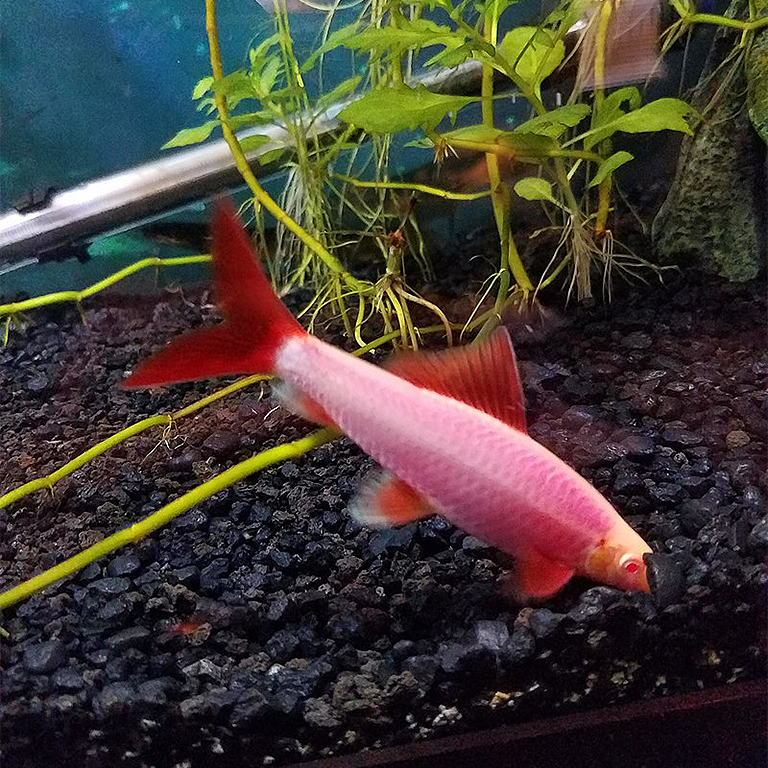
- A recent study shows that genetically modified zebrafish, known as GloFish, have been found and are breeding in creeks in Brazil’s Atlantic Forest.
- GloFish, which are genetically engineered for fluorescence, are readily available for sale online in Brazil, even though they’ve been banned there since 2017.
- Brazilian biologists have called for measures to prevent these fish from escaping fish farms and entering into local bodies of water, where they compete with native species for food.
- But a U.S biologist whose own research showed that GloFish fail to compete reproductively against wild-type zebrafish says this new paper is “almost a study about nothing” and was published only because it was “sensational.”
One of Brazil’s most threatened biomes, the Atlantic Forest, now faces a new hazard: genetically modified zebrafish that glow in the dark.
Despite these so-called GloFish being officially banned in the country, researchers caught specimens in all five sampled headwater creeks in the southeastearn Paraíba do Sul River Basin. The basin covers 55,500 square kilometres (21,400 square miles) across the states of São Paulo, Minas Gerais and Rio de Janeiro, and is considered the Brazilian watershed that has been the most heavily impacted by human activity.
“I am very concerned because these non-native fish can have serious ecological impacts, such as competing [with native fish] over food and predating native fish,” André Magalhāes, a biologist at the Federal University of São João del-Rei in Minas Gerais state and lead author of a recently published study, told Mongabay in an email.
Some of the native fish could be driven into extinction by these GloFish and other introduced species, he said. “Apart from many species of non-native fish, we now have non-native hybrid fish and, worst of all, non-native genetically modified fish, like the transgenic zebra fish [in our water courses].”

This study, Magalhães said, is the first to explore life-history strategies of genetically modified zebrafish (Danio rerio) in the wild. These fish feed on the insects and zooplankton that native fish also eat, putting them in direct competition, he said. And in the creeks where they occur, there are no predators to keep their numbers in check, he added.
Magalhães said this means the creeks have become susceptible to invasion by alien species. Moreover, although it’s widely believed that GloFish (which include other fish species engineered for fluorescence) are infertile, the study found that these fish were reproducing in two creeks. In one of them, the Queiroga creek, “they reproduce every month of the year,” Magalhães said.
This adds up to a worrying situation, he said: “The risk of these exotic fish leading to the extermination of native fish is real and will get worse, unless the authorities take action to stop their escape.”
Jean Vitule, a fish expert from the University of Paraná who was not involved in the study, agrees: “I am really worried [by the findings], because the arrival of the GM fish in this river basin is a shot in the dark,” he told Mongabay by email. “We don’t know how severe the problems will be, as they are escaping into a little studied region.”


Controversial GloFish
In the late 1990s, the National University of Singapore created the first genetically modified fish by adding genes for red and green fluorescent proteins from sea anemones and jellyfish into wild zebrafish, a species native to South Asia that’s popular in the aquarium fish trade. U.S. company Yorktown Technologies obtained the marketing rights from the NUS scientists, and began producing and selling these fish under the trade name GloFish.
The U.S. Food and Drug Administration (FDA) showed little concern about the environmental risk these fish posed. “There is no evidence that these genetically engineered zebra danio fish pose any more threat to the environment than their unmodified counterparts which have long been widely sold in the United States,” it said in a statement published in 2003. “In the absence of a clear risk to the public health, the FDA finds no reason to regulate these particular fish.”
A study published in 2015 seemed to confirm the FDA’s assessment. Researchers from Purdue University in the U.S studied more than 18,500 adult zebrafish, both wild-type and GloFish, from 18 populations across 15 generations. They found that even though the female zebrafish preferred genetically modified males as mates, the wild-type males were far more aggressive.
This was what won out. “The wild-type males drove away the reds and got all the mates and that drove the transgene [genetically modified fish] to extinction,” William Muir, the senior author of the study and the biologist who did the risk assessment for the FDA, told Mongabay in a video interview. Wild-type males sired 2.5 times as many young as the GloFish males.

“If we make a transgenic organism that has reduced fitness in the wild, evolution takes over and removes it,” Muir said. “Nature experiments with mutations all the time, and it only saves the best of the best.”
He added he believes the Brazilian scientists may be exaggerating the risks, saying the new research is “almost a study about nothing. They got it published in a high-quality journal just because it is sensational.” Muir said that while there is some cause for concern, it’s “not because a GM fish has been found, but because the region is undergoing an exotic invasion.”
But Magalhães disagrees. “Professor Muir’s research was in a laboratory, while ours was in the wild,” he said. “In a lab, you can control the variables, but in the wild, you cannot.”
They cannot be sure, for instance, that the genetically modified species will lose out, especially in an ecosystem where it has no native predators. And the idea of fluorescent fish proliferating in the Atlantic Forest fills him with horror, Magalhães said.

The study recommends installing simple devices such as nets at fish farms to prevent or reduce instances of GloFish escaping. In the event that they do escape, retention ponds should be built that are stocked with native predatory fish, such as dogfish (Oligosarcus hepsetus), which would feed on the zebrafish before they can reach a natural body of water. It also calls for encouraging the breeding by local ornamental fish farms of species native to the region, instead of exotics like zebrafish, and says a total ban on genetically modified fish in Brazil, as recommended by environmental regulator IBAMA, must be enforced.
According to Magalhães, the import of transgenic fish was banned by IBAMA in 2017 but the page on its website detailing the prohibition, which he accessed in March 2020, has disappeared. IBAMA did not reply to Mongabay’s request for clarification. However, the IBAMA website provides evidence that the ban on the import of GM fish is still valid by excluding GM fish from the list of fish that can legally be imported.
Yet GM fish continue to be available for purchase online in Brazil. Here, a pink GloFish known as Paulistinha Rosa is advertised for sale from an aquarium supplier in northeastern Piauí state. Other suppliers post videos of GM fish on Facebook, including this one by an aquarium supplier in Manaus, to draw customers to their store. The aquarium suppliers didn’t respond to Mongabay’s request for comment.
Banner image: Transgenic zebrafish expressing different fluorescent colours. Image by Karen Swain via Flickr (CC BY-NC-ND 2.0).
Citations:
Magalhães, A. L., Brito, M. F., & Silva, L. G. (2022). The fluorescent introduction has begun in the southern hemisphere: Presence and life-history strategies of the transgenic zebrafish Danio rerio (Cypriniformes: Danionidae) in Brazil. Studies on Neotropical Fauna and Environment, 1-13. doi:10.1080/01650521.2021.2024054
Howard, R. D., Rohrer, K., Liu, Y., & Muir, W. M. (2015). Mate competition and evolutionary outcomes in genetically modified zebrafish (Danio rerio). Evolution, 69(5), 1143-1157. doi:10.1111/evo.12662
FEEDBACK: Use this form to send a message to the author of this post. If you want to post a public comment, you can do that at the bottom of the page.
GM fish engineered to glow in the dark are found in Brazil creeks
Source: Trends News

0 Comments